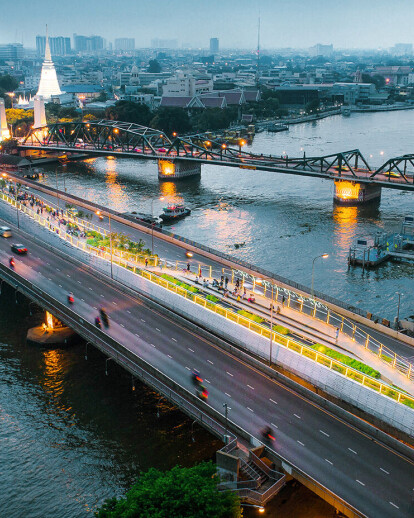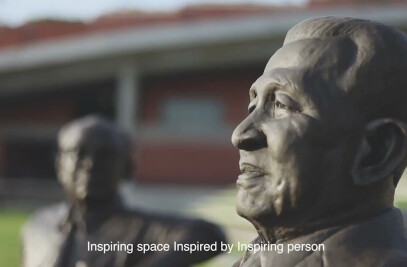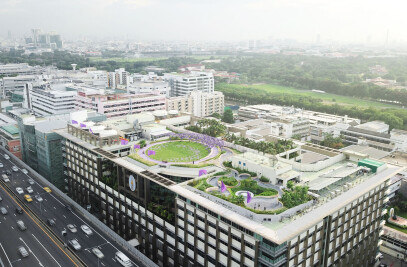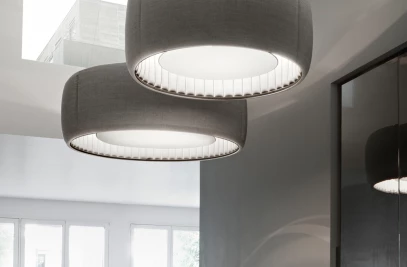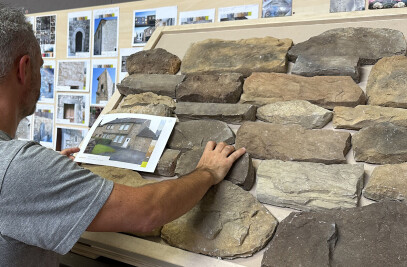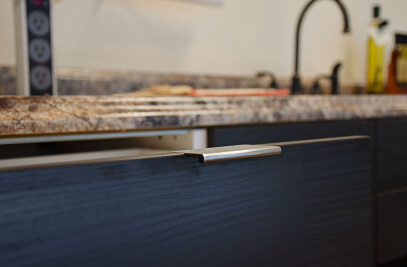" Amidst the pandemic, the Bangkok Metropolitan Administration opened its remarkable public space, the Chao Phraya Sky Park (CPSP). Left abandoned for almost 40 years, the halted infrastructure project has now been given a second life as the newest Bangkok landmark, the nation's first pedestrian bridge park across a river.
Situated in Bangkok's most significant historical area, the 360-degree view bridges the city‘s historic town and modern skyline at one glance. From vacant to vibrant, CPSP exhibits few possibilities for public green space in such a dense urban fabric to redefine their neglected infrastructure, the health of the citizens with the health of their city. By merging two juxtaposed sides of Bangkok and existing parks on both ends, CPSP shows the importance of much-need public green space, walkability, creating low carbon-emission construction from adaptive reuse while restoring its citizens' physical and mental health. By utilizing the remains, CPSP has shown the countless future possibilities for placemaking that increase urban adaptability and all the city's abandons and wasted spaces that could not be left behind."
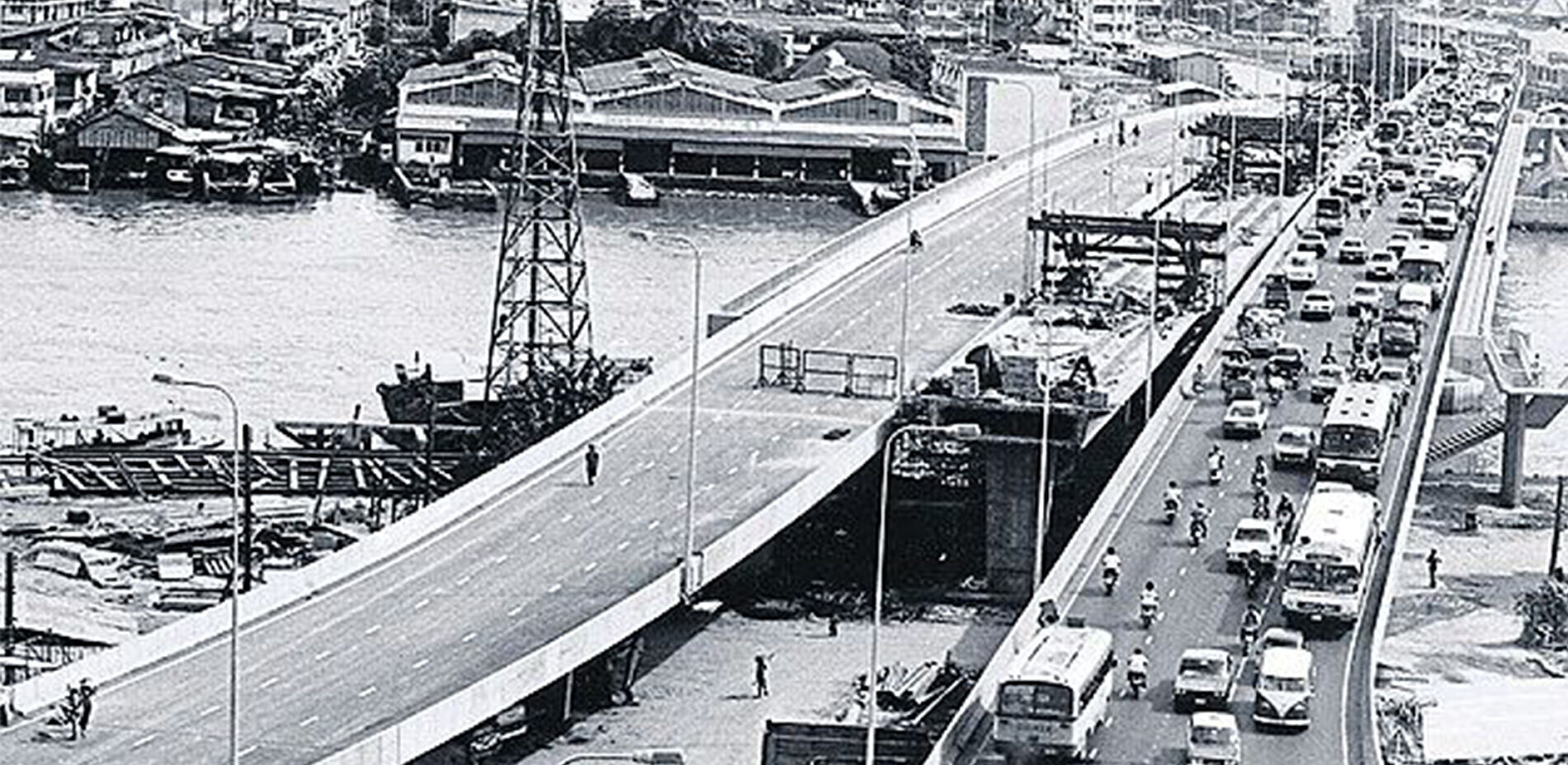
Finishing the unfinished dream
In 1984, Bangkokians anticipated a hopeful milestone, looking forward to being the first nation to establish a sky train in Southeast Asia. The Lavalin Skytrain rail would carry commuters from both sides of Bangkok through heritage districts across the city's main artery, the Chao Phraya River. The railway would share its load with the two existing roadways of the Phrapokklao Bridge in a gap of 8.5 meters wide and 280 meters long.
Not long after completing its structure with Phrapokklao Bridge, political interference placed the project in a deadlock. The Government's decision later confirmed that the sky train would never come.
This 40-years failed mega infrastructure had stood abandoned as the city's unfinished dream, representing uncompensated opportunity lost. As Bangkok progressed into a bustling metropolis, the Lavalin Skytrain structure left forgotten free-standing amidst the dense city landscape. For its incompleteness and inaccessibility, Bangkokians named this wasted infrastructure "Saphan Duan" or "amputated bridge."
In 2015, the Bangkok250 project, led by the Department of City Planning and Urban Development, Bangkok Metropolitan Administration (BMA), Chula Unisearch and Urban Design Development Center, and Chulalongkorn University, was set up to revitalize central districts of Bangkok. Several public discourses were held to involve the public in the decision-making. At one meeting, a community leader asked, "Why not put this useless bridge to good use, so our children could walk across the river to school?".
Having their voices heard, community members demanded their right to cross the river on foot. Since vacant areas along the riverfront in central Bangkok were occupied either by informal settlements or luxurious hotels, why not create a new public green space over the river? Why not also complete the incomplete dream of the Lavalin Skytrain to connect people? After being long forgotten, the amputated bridge was finally given a chance, a new life as the Chao Phraya Sky Park (CPSP).
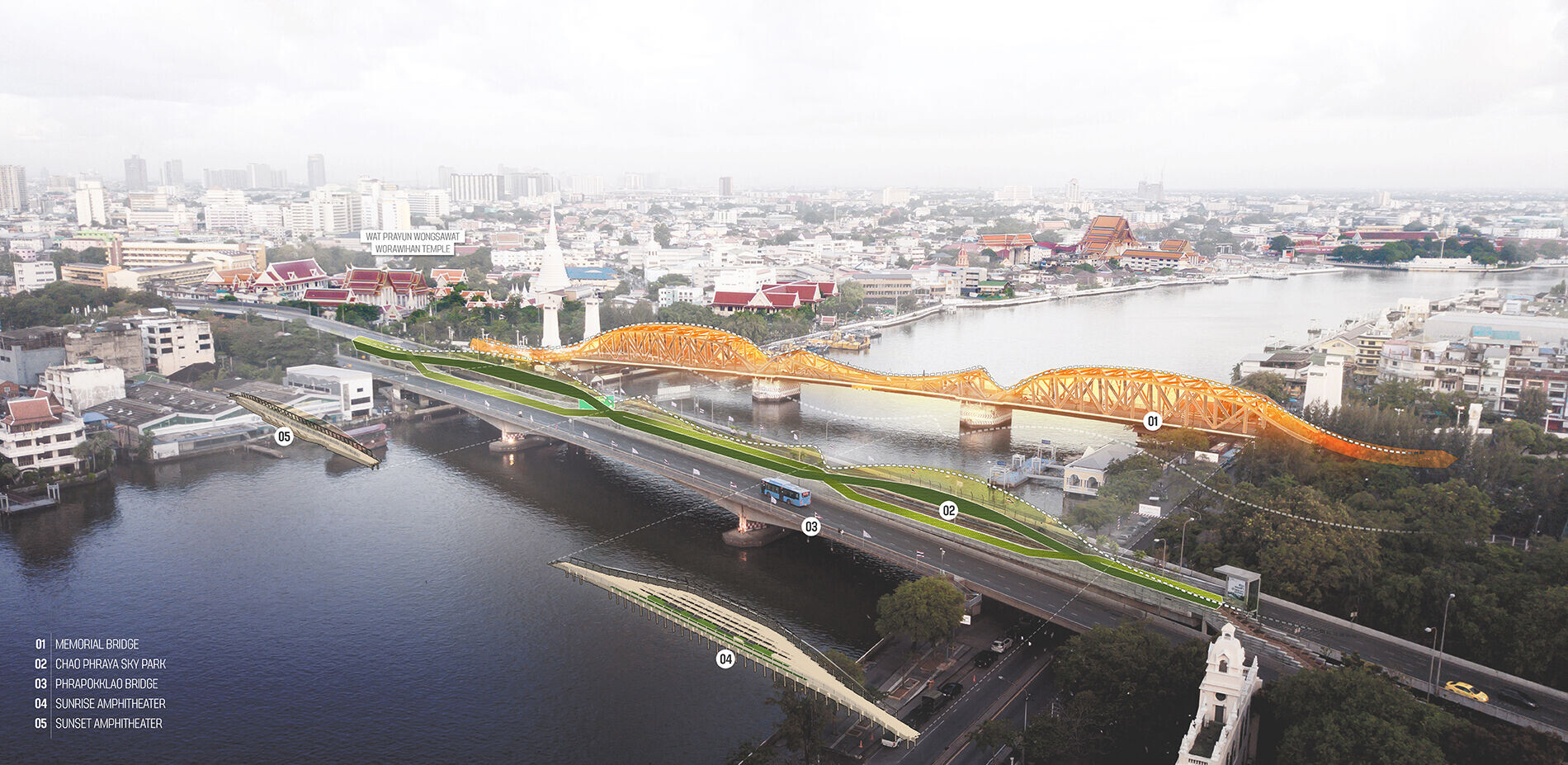
Bridging the past to the present
Left useless amidst the city's most significant historical area, the amputated structure is next to one of the nation's most important monuments: the Memorial Bridge (Saphan Phut). The first vehicle bridge across the Chao Phraya River is a tribute to King Rama I, the founder of Bangkok.
Inspired by the elements of the Memorial Bridge, the team of landscape architects and architects decided that the new structure should not compete with its predecessor but rather respect it. Emulating the curves of the Memorial Bridge in a contemporary manner, the CPSP humbly weaves the slopes of its precedent counterpart to adorn the city's skyline in unison.
For almost a century, the Memorial Bridge has been one of the few spots in the city where Bangkokians and tourists—previously standing on a tiny passage next to busy traffic—could adore the whole scenery of Bangkok with the Chao Phraya River. The Memorial Bridge has been given its place in the frame to be part of the picture. From the CPSP, pedestrians can enjoy a view with the Memorial Bridge in the foreground, overlooking Bangkok's postcard destinations like the Temple of Dawn (Wat Arun), the Temple of the Reclining Buddha (Wat Pho), and the Wichai Prasit Fort. With a 360-degree panoramic view of Bangkok over the River of the Kings, the Sky Park gives all Bangkokians a unique viewpoint to see the city's past and present at a glance.
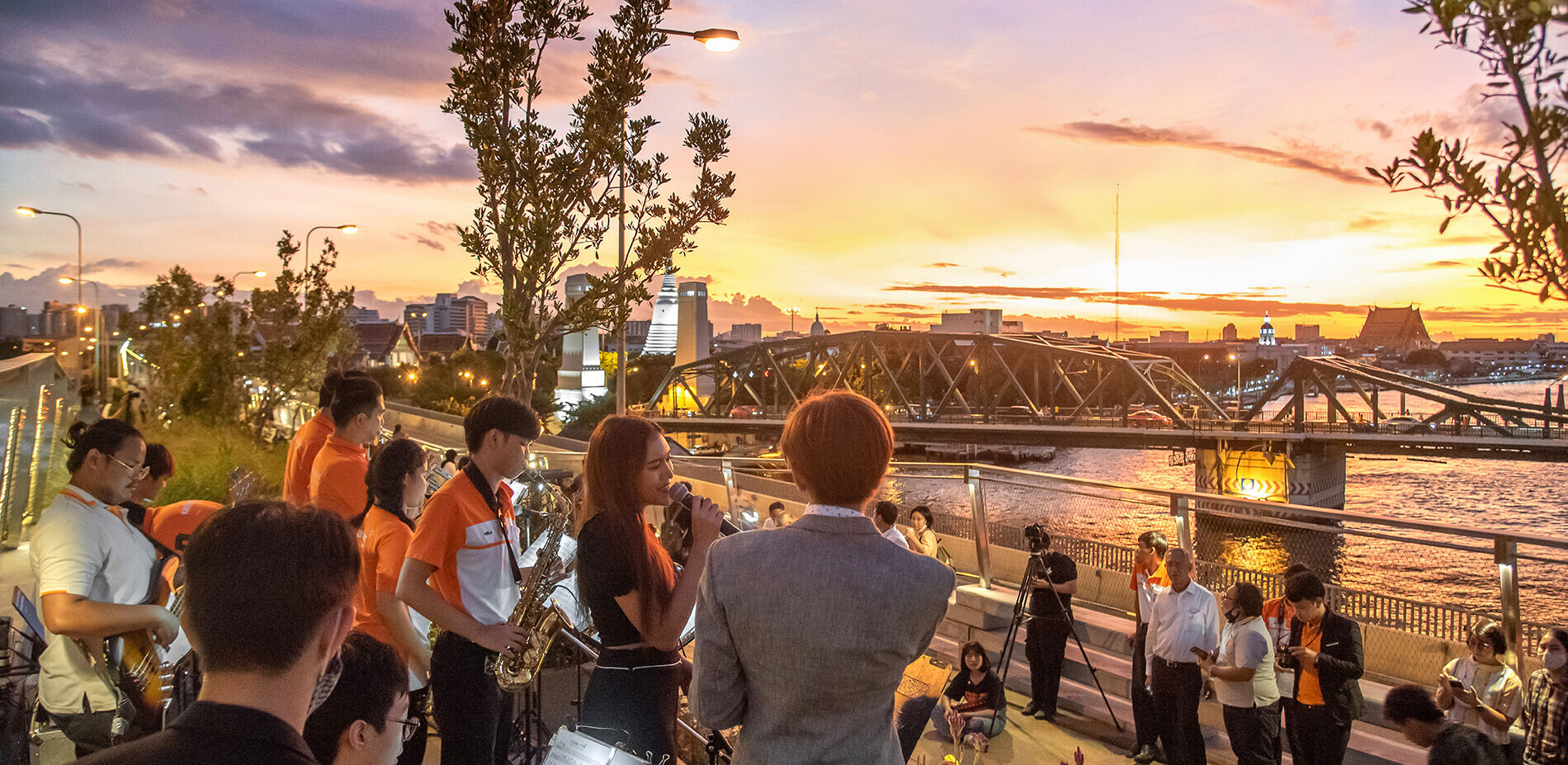
Widening spaces while lengthening experiences
By merging two existing community parks across the river, CPSP becomes part of the park's connectivity on both ends. Squeezed between two sides of heavy traffic with just 8.5 meters of width, designers made rooms out of the narrowness by splitting this linear space into two interweaving pathways. The two divided pathways weaving allows ultimate space perception. Its separated spatial linear forms offer various speeds and activities, such as walking, running, biking, or roaming across the bridge park. In addition, the CPSP allows pedestrians a safe and beautiful strolling experience by elevating all park structures higher than the roadways on both sides, which also reduces the disruptions caused by the traffic noise and pollution below.
Cutting across the shortest section of the river, the bridge length of 280-meter appears straightforward in the visual distance. However, the designers' team aims to create a sense of exploration for pedestrians by hiding visual endpoints on both ends. For that reason, the outlook steps on both ends are rising as part of intertwining walkways that lengthen users' experience.
At The Sky Park's midpoint, where the two divided pathways are combined, part of the path is weaving up to form the bridge's hilltop walkway curve. The small cascading steps carve out sitting areas and a linear performance stage for special occasions.
The Sky Park's design also opens up new and unique outlooks to admire the sunrise and sunset over the river, juxtaposing Bangkok's historic and modern skyline on each side. In addition, the crisscross design of the varying elevations of pathways ensures linear space visibility, promoting a safe environment where all visitors can see and be seen. Just as important, inclusivity is prioritized with lifts, rails, wheelchair ramps, and other universal design elements across the park to enable access to all users.
Design with Limitation
Building an entire park on a 40-year-old abandoned, inaccessible Sky rail infrastructure is no easy feat. For on-site investigation, the landscape architects and architects team needed to estimate all dimensions and experience as if they were walking on the amputation structure due to inaccessibility. In addition, with weight limitations, the soil depth and the additional structure on the existing were critical concerns during the design process.
Between the right of way of 8.5 meters, the design elements and construction process cannot disrupt or obstruct the parallel traffic on both sides. With space and time constraints, the designers built all bridge park structures with a module system of precast GRC blocks, saving both construction time and cost. These GRC blocks were assembled into various units, forming walls of diverse topography, planters, railing, and seating, framing the whole walking and driving experience inside out and outside in.
The wind force is a crucial factor for both the hardscapes and softscapes. The planting design consists of various low-maintenance plants—requiring less soil and having high resistance to wind and sun—with branches and forms that don't widely spread and obstruct both roadways and driving viewpoints. These trees and the diverse layers of plants will change color throughout the seasons and give the city a new vibrant palette. By bridging not just people but also wildlife, these native species promote urban biodiversity by providing a microclimate and green corridor for pollinators and insects.

From Vacant to Vibrant.
The CPSP opened during the first pandemic lockdown in Bangkok as a call for action that we need to further address public health together with public green space, climate crises, and how urgent we need to build our resilient cities.
Despite all adversities in making CPSP possible, the project is a big step forward in collaboration with all stakeholders, all professionals at par, urban designers, landscape architects, architects, and engineers. Solving the city's most pressing issues in a low-carbon context, CPSP offers the solution by reducing carbon emissions in the construction process with adaptive reuse. The bridge park also increases green space and walkability and enhances public health and climate resilience.
Completing an unfinished dream, the CPSP is an example of how we can adapt and healthily coexist with one another and our environment. With respect to limited resources, there are emerging possibilities to which we can reinvent our world to better adapt to climate change, pandemics, and other uncertainties that lie ahead. All by repurposing the useless and rethinking the conventional, as a result, we can move forward to create a better city with what we have and future countless abandoned infrastructures that should not be left behind.
Project Owner: Bangkok Metropolitan Administration (BMA)
Project Leader: Department Of City Planning and Urban Development (BMA),
Urban Designer : Chula Unisearch, Chulalongkorn University
Urban Design Development Center (UDDC), Chulalongkorn University
Landscape Design : Kotchakorn Voraakhom
Architecture Design : Chakdao Navacharoen
Civil Engineer: Pisitsak Serklin, Sukkawich Thepchana
Structural Engineer: Thummanuun Susumphao, Ph.D.
Project Contractor: SGR Enterprise Company Limited
Community Participation: Cultural Tourism Community Kadi Chin- Klong San
